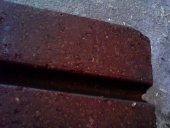posted 13 years ago
Absolutely, the lack of insulation on the heat riser will cause the problem you describe. The system is designed so it 'balances' when cold, serving kind of like the U-trap in your sink to slow the flow of gas. When you heat up the heat riser HOTTER THAN the barrel, and the barrel radiates heat and cools the exhaust down again to only a few hundred degrees, then you have a convenction-cell or thermosiphon 'pump' that keeps things moving. But if there is no insulation, soon the heat riser will radiate too much heat to the barrel, and they will equalize in temperature at a new, hotter, level. Turns it back into a U-trap again. Try the insulation.
Wet wood will also sometimes cause the problem you describe. Get the wood under shelter, use older wood (1-2 years under dry shelter), down to 15-20% moisture or less.
It's hard to keep fuel dry in a garden, the ground is moist and there's a tendency to set kindling on all kinds of moist surfaces. Make a dry box for your wood by the heater while you play. Any fire will go out if you put dry tinder to wet wood; the small kindling will burn up and the bigger, damp sticks won't catch. Water robs heat from the fire; steam evaporating from the wood robs even more; and air robs some heat as it flows past. The air adjustment makes me think you are just not getting hot enough in there at first - by 15 minutes you should be getting some serious ignition, and by about 30-45 minutes the bricks should be getting hot enough to bake fresh kindling dry or even ignite matchwood that is put down there regardless of whether there are still flames going from the other wood. The bricks getting hot is part of what helps the fire burn clean.
If possible, stay by the fire and tend it while it is starting. You can't feed in a lot of wet wood all at once without smothering it, so you have to gradually build the fire up at a rate that dries the next-size wood as you go. Stay by it until you have a full wood-box of sticks at least 1" thickness as your main fuel load - then check it again in about 30-45 minutes, as these burn down add 2" sticks, loading fresh wood behind the burning fuel so the fire is not interrupted by cold. When you get a nice set of chunky embers in another hour or so, put on a 4.5" or 5" round log to almost fill your feed. As the fire dies down, put tomorrow's kindling on a warm dry part of the heater. Once dead, close the opening with a couple of bricks so you don't get rain down the feed or dew at night.
Once you get it insulated, you can also just set the kindling inside the bricks of the feed (still warm from last night's fire, but after the embers have gone out), and let it dry out and pre-heat nicely. Wood ash (when dry) makes a decent insulation. Sawdust mixed in clay slip does OK too, or straw dipped in clay/dirt slurry; both will burn out but leave a clay 'foam' behind.
I like how you have laid out the round base under the barrel. Maybe it's a woman thing - it drives Ernie nuts when I build my 'brick beehives,' he says nobody can follow it - but I find it much easier than trying to get bricks to stay square and match up course by course, only to bring it back to a round shape when I need to add the barrel. You've done an unusual pattern of pairs, when you do your indoor one you may want to alternate them so there aren't so many running vertical joins, but it's very pretty and symmetrical. Your garden soil looks marvelously dark.
Yours,
Erica




















 .
.



































